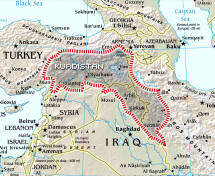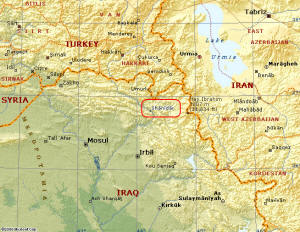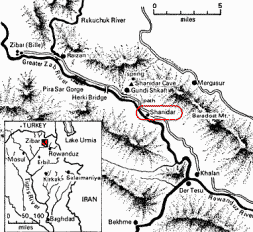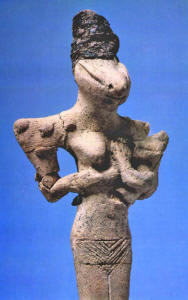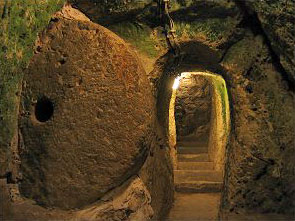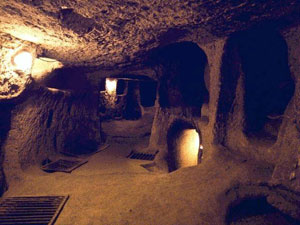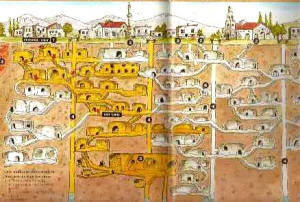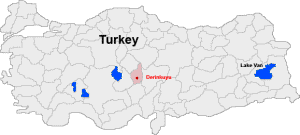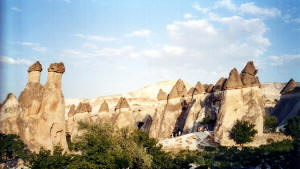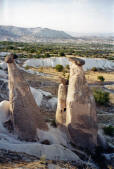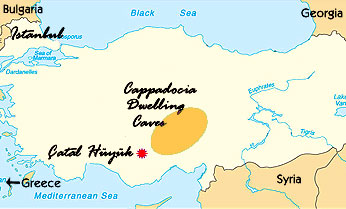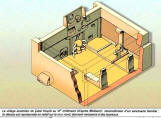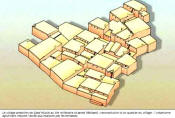|
|
|
(January-February, 1997)
For the last 2000 years this has been the stereotypical image fostered by the Christian Church.
Many people see the Pentateuch, the first five books of the Old Testament, as littered with accounts of angels appearing to righteous patriarchs and visionary prophets.
Yet this is simply not so.
There are the three angels who approach Abraham to announce the birth of a son named Izaac to his wife Sarah as he sits beneath a tree on the Plain of Mamre. There are the two angels who visit Lot and his wife at Sodom prior to its destruction.
There is the angel who wrestles all night with Jacob at a place named Penuel, or those which he sees moving up and down a ladder that stretches between heaven and earth. Yet other than these accounts, there are too few examples, and when angels do appear the narrative is often vague and unclear on what exactly is going on.
For instance, in the case of both Abraham and
Lot the angels in question are described simply as 'men', who sit
down to take food like any mortal person.
It was even later, around 200 BC, that
they began appearing with frequency in Judaic religious literature.
Works such as the Book of Daniel and the apocryphal Book of Tobit
contain enigmatic accounts of angelic beings that have individual
names, specific appearances and established hierarchies. These
radiant figures were of non-Judaic origin. All the indications are
that they were aliens, imports from a foreign kingdom, namely
Persia.
These included not only
Zoroastrianism, after the prophet Zoroaster or Zarathustra, but also
the much older religion of the Magi, the elite priestly caste of
Media in north-west Iran. They believed in a whole pantheon of
supernatural beings called ahuras, or 'shining ones', and daevas -
ahuras who had fallen from grace because of their corruption of
mankind.
Moreover, there can be little doubt that Magianism, from which we
get terms such as magus, magic and magician, helped to establish the
belief among Jews not only of whole hierarchies of angels, but also
of legions of fallen angels - a topic that gains its greatest
inspiration from one work alone -
the Book of Enoch.
Yet not the fall of angels in general, but those which
were originally known as 'Œrin ('Œr in singular), 'those who watch',
or simply 'watchers' as the word is rendered in English translation.
One of their number, a leader named Azazel, is said to have
'taught men to make swords, and knives, and shields, and
breastplates, and made known to them the metals (of the earth) and
the art of working them', indicating that the Watchers brought the
use of metal to mankind. He also instructed them on how they could
make 'bracelets' and 'ornaments' and showed them how to use
'antimony', a white brittle metal employed in the arts and medicine.
One of their number, Pˆnˆm–e, taught 'the bitter and the sweet', surely a reference to the
use of herbs and spices in foods, while instructing men on the use
of 'ink and paper', implying that the Watchers introduced the
earliest forms of writing. Far more disturbing is Kƒsdejƒ, who is
said to have shown 'the children of men all the wicked smitings of
spirits and demons, and the smitings of the embryo in the womb, that
it may pass away'. In other words he taught women how to abort
babies.
Why should they have needed to work with metals, use
charms, incantations and writing; beautify the body; employ the use
of spices, and know now to abort an unborn child? None of these
skills are what one might expect heavenly messengers of God to
possess, not unless they were human in the first place.
By now the cries of desperation from mankind were being heard loud and clear by the angels, or Watchers, who had remained loyal to heaven. One by one they are appointed by God to proceed against the rebel Watchers and their offspring the Nephilim, who are described as 'the bastards and the reprobates, and the children of fornication'. The first leader, Shemyaza, is hung and bound upside down and his soul banished to become the stars of the constellation of Orion.
The second leader, Azazel, is bound hand and foot, and cast for eternity into the darkness of a desert referred to as D–dƒˆl. Upon him are placed 'rough and jagged rocks' and here he shall forever remain until the Day of Judgment when he will be 'cast into the fire' for his sins.
For their part in
the corruption of mankind, the rebel Watchers are forced to witness
the slaughter of their own children before being cast into some kind
of heavenly prison, seen as an 'abyss of fire'.
He attempts to reconcile them with the angels of heaven, but fails miserably. After this the Book of Enoch relates how the patriarch is carried by angels over mountains and seas to the 'seven heavens'.
Here he sees multitudes of angelic
beings watching stars and other celestial bodies in what appear to
be astronomical observatories. Others tend orchards and gardens that
have more in common with an Israeli kibbutz than an ethereal realm
above the clouds. Elsewhere in 'heaven' is Eden, where God planted a
garden for Adam and Eve before their fall - Enoch being the first
mortal to enter this domain since their expulsion.
Thus ends the story of the Watchers.
Scholars would say no. They believe it to be a purely fictional work inspired by the Book of Genesis, in particular two enigmatic passages in Chapter 6.
The first, making up Verses 1 and 2, reads as follows:
By 'sons of God ' the text means heavenly angels, the original Hebrew being bene ha-elohim.
In Verse 3 of Chapter 6 God unexpectedly pronounces that his spirit cannot remain in men for
ever, and that since humanity is a creation of flesh its life-span
will henceforth be shortened to 'an hundred and twenty years'. Yet
in Verse 4 the tone suddenly reverts to the original theme of the
chapter, for it says:
If this was the case, then there is no reason why the lines of Genesis 6 could not have been tampered with around this time. In an attempt to emphasize the immense antiquity of the Book of Enoch, Hebrew myth has always asserted that it was originally conveyed to Noah, Enoch's great grandson, after the Great Flood, i.e. long before the compilation of Genesis.
This claim of
precedence over the Pentateuch eventually led the Christian
theologian St Augustine (AD 354-430) to state that the Book of Enoch
was too old (ob nimiam antiquitatem) to be included in the
Canon of Scripture!
And also after that...
Theologians are aware of this dilemma, and get around the problem by suggesting that the angels fell from grace twice - once through pride and then again through lust. It seems certain that the term Nephilim was the original Hebrew name of the fallen race, while bene ha-elohim was a much later term - plausibly from Iran - that entered Genesis 6 long after its original compilation.
So if the Watchers and the Nephilim really had inhabited this world,
The Book of Enoch was a vital source of knowledge with regard to their former existence, but I needed more - other less tainted accounts of this apparent race of human beings.
This connection was strengthened after 1947 when it was realized that among the Dead Sea Scrolls, now considered to have been written by the Essenes, were various fragments of texts belonging to several copies of the Book of Enoch.
Up until this time the only complete
manuscript copies available to the literary world had been various
copies written in the Ethiopian written language of Ge'ez, the first
of which had been brought back to Europe by the Scottish explorer
and known Freemason James Bruce of Kinnaird following his famous
travels in Abyssinia between 1769 and 1772.
Many of these individual fragments were
eventually realized by Dead Sea scholar J. T. Milik to be
extracts from a lost work called the
Book of Giants. Previously this
had only been known from isolated references in religious texts
appertaining to the Manichaeans, a heretical gnostic faith that
swept across Europe and Asia, as far as China and Tibet, from the
third century AD onwards.
Reading this ancient work allows the reader a more compassionate
view of the Nephilim, who come across as innocent bystanders in a
dilemma beyond their personal control.
What is much more significant is the appearance of the two Watchers who appear to him in a dream-vision as he rests in his bed, for as the heavily reconstructed text reads:
The text identifies this last Watcher as Belial, the Prince of Darkness and King of Evil, while his companion is revealed as Michael, the Prince of Light, who is also named as Melchizedek, the King of Righteousness.
It is, however, Belial's frightful appearance that took my attention, for he is seen as terrifying to look upon and like a 'serpent', the very synonym so often used when describing both the Watchers and the Nephilim. If the textual fragment had ended here, then I would not have known why this synonym had been used by the Jewish scribe in question.
Fortunately, however, the text goes on
to say that the Watcher possessed a visage, or face, 'like a viper'.
Since he also wears a cloak 'many-coloured yet very dark', I had
also to presume that he was anthropomorphic, in other words he
possessed human form.
In the media publicity that inevitably surrounded this drugs-related incident, it emerged that the Viper Room gained its name many years beforehand when it had been a jazz haunt of some renown.
Story goes that the musicians would take the stage and play long hours, prolonging their creativity and concentration by smoking large amounts of marijuana.
Apparently, the
long term effects of this drug abuse, coupled with exceedingly long
periods without food and sleep, would cause their emaciated faces to
appear hollow and gaunt, while their eyes would close up to become
just slits. Through the haze of heavy smoke, the effect was to make
it seem as if the jazz musicians had faces like vipers, hence the
name of the club.
It seemed as likely a possibility as any, although
it was also feasible that their serpentine connection related to
their accredited magical associations and capabilities, perhaps even
their bodily movements and overall appearance.
The passage refers to the unexpected arrival of two Watchers as Enoch rests on his bed:
White skin (often ruddied 'as red as a rose'), tall stature and facial radiances 'like the sun' all recur frequently in connection with the appearance of angels and Watchers in Enochian and Dead Sea literature.
Yet what was this reference to their
dress having 'the
appearance of feathers'? Might it relate in some way to the 'cloak'
worn by the Watcher named Belial who appears in the Amram story,
which was said to have been 'many-coloured yet very dark', precisely
the effect one might expect from a coat of black feathers, like
those belonging to crows or vultures perhaps?
This
has almost certainly been the case in the above account taken from 2
Enoch, which was re-copied many times during the early years of
Christianity.
Surely this confusion between wings
and feather coats could have been edited to give the Watchers a more
appropriate angelic appearance.
The use of totemic forms, such as animals and birds, has always been the domain of the shaman, the spirit walkers of tribal communities. In many early cultures the soul was said to have taken the form of a bird to make its flight from this world to the next, which is why it is often depicted as such in ancient religious art.
This idea may well have stemmed from the
widely-held belief that astral flight could only be achieved by
using ethereal wings, like those of a bird, something that almost
certainly helped inspire the idea that angels, as messengers of God,
should be portrayed with wings in Christian iconography.
Totemic shamanism is more-or-less dependent on the indigenous animals or birds present in the locale of the culture or tribe, although in principle the purpose has always been the same - using this mantle to achieve astral flight, divine illumination, spirit communication and the attainment of otherworldly knowledge and wisdom.
Not understanding the purpose of this allegory they put the subject to the Nephilim council who appoint one of their number, Mahawai, to go on their behalf to consult Enoch, who now resides in an earthly paradise.
To this end Mahawai then:
Enoch explains that the 200 trees represent the 200 Watchers, while the felling of their trunks signifies their destruction in a coming conflagration and deluge. More significant, however, is the means by which Mahawai attains astral flight, for he is said to have used 'his hands like (a) [winged] eagle.'
Elsewhere in the same Enochian text Mahawai is said
to have adopted the guise of a bird to make another long journey. On
this occasion he narrowly escapes being burnt up by the sun's heat
and is only saved after heeding the celestial voice of Enoch, who
convinces him to turn back and not die prematurely - a story that
has close parallels with Icarus's fatal flight too near the sun in
Greek mythology.
Angels in Paradise
This
is tentatively confirmed by another Dead Sea text entitled the
Genesis Apocryphon which records that after his ascent to heaven the
patriarch Enoch spent the rest of his life 'among the angels' in
'paradise'. Although the term 'paradise' is used in some
translations of the original text, the actual word is 'Parwain'.
These would have included the region of Parsa to its south and, more significantly, the mountainous region
known as Parsua to its west. Was Enoch therefore believed to have
lived 'among the angels' in the harsh mountainous territories beyond
the limits of the ancient kingdom of Media? In the remote region of Parsua, to the west of Media, perhaps? Is this where the Watchers
came from? It is from here that they descending on to the plains to
take mortal wives and reveal the forbidden arts and secrets of
heaven?
This enormous, mostly desolate part of the earth, home in the most part to wandering nomads, bands of warring rebels, isolated religious communities and the occasional village, town or city, is known to the world as Kurdistan - the cultural and political homeland of the much troubled Kurdish peoples.
Yet according to biblical and apocryphal tradition, it was
here also that the Garden of Eden, the resting place of Noah's Ark
and the stomping ground of the early patriarchs could be found. It
was here too that I now realized I would have to go in search of
the
realm of the immortals.
Here Adam and Eve became humanity's first parents before
their eventual fall from grace through the beguiling of the subtle
Serpent of Temptation. Serpents were not only a primary synonym for
the Watchers and Nephilim, but the Book of Enoch even states which
'Serpent', or Watcher, led our first parents into temptation.
Interestingly enough, the Bundahishn, a holy text of the Zoroastrian
faith, cites Angra Mainyu, the Evil Spirit and father of the daevas,
as assuming this same role, and like the Watchers he too is
described as a serpent with 'legs'.
This is not, however, its
true origin. The word 'Eden' is in fact Akkadian - the proto-Hebrew,
or Semitic, language introduced to Mesopotamia (modern-day Iraq) by
the people of Agade, or Akkad, a race that seized control of the
ancient kingdom of Sumer during the second half of the third
millennium BC. In their language the word 'Eden', or edin,
meant a 'steppe' or 'terrace', as in a raised agricultural terrace.
The English word 'heaven', on the other hand, is taken from the
Hebrew ha'shemim, interpreted as meaning 'the skies'.
It can also refer to 'high places', such as lofty settlements. Moreover,
the Hebrew word-root shm can mean 'heights', as well as
'plant' or 'vegetation', implying perhaps that the word 'heaven'
might be more accurately translated as a 'planted highlands'.
The Rivers of Paradise
The names of these are given as the Pishon, Gihon, Hiddekel and Euphrates. Of these four, only the last can properly be identified by name. The Euphrates flows through Turkish Kurdistan, Syria and Iraq before emptying into the Persian Gulf.
The other three were identified by early biblical scholars respectively with the Ganges of India (although occasionally the Orontes of northern Syria), the Nile of Africa and the Tigris of western Asia, which, like its sister river the Euphrates, flows through Iraq and empties into the Persian Gulf.
The first two were chosen as suitable
substitutes simply because they were looked upon by scholars as the
mightiest rivers of the classical world; only the connection between
the Hiddekel and the Tigris made any sort of geographical sense.
Other sources, particularly the Armenian Church,
accepted the Euphrates and Tigris as two of the four rivers of
paradise, yet chose to associate the other two, the Pishon and Gihon,
with, respectively, the Greater Zab, which rises in Turkish
Kurdistan and empties into the Tigris, and the Araxes, which rises
in Armenia and empties into the Caspian Sea.
The Heavenly Mountain
The mythologies of both the Sumerians, who ruled the various Mesopotamian city-states from around 3000 BC onwards, and their eventual conquerors, the Akkadians, placed the homeland of the Gods in this exact same region.
The Akkadians originated as a Semitic,
or proto-Hebrew, race of uncertain origin, and in their religious
literature this heavenly abode is referred to as Kharsag Khurra, the
heavenly mountain. Here the Gods, also known as the Anannage, lived
in a paradisiacal realm with gardens, orchards, temples and
irrigated fields that not only resemble the Seven Heavens described
in the Book of Enoch, but is actually referred to on more than one
occasion as edin, the Akkadian for 'steppe' or 'plateau'.
These undoubtedly equate with the seven archangels of post-exilic Judaism as well as the six so-called Amesha Spentas, or 'bounteous spirits', who with the supreme God Ahura Mazda, preside over the angelic hierarchies in Iranian tradition.
The Search for Dilmun
Here, it was said, the God Ea and his wife were placed to institute 'a sinless age of complete happiness'. Here too animals lived in peace and harmony, man had no rival and the God Enlil 'in one tongue gave praise'.
It is also described as a pure, clean and
'bright' 'abode
of the immortals' where death, disease and sorrow are unknown and
some mortals have been given 'life like a God', words reminiscent of
the Airyana Vaejah, the realm of the immortals in Iranian myth and
legend, and the Eden of Hebraic tradition
Furthermore, Ea (the Akkadian Enki) was said
to have presided over the concourse of Mesopotamia's two greatest
rivers - the Tigris and Euphrates - which are shown in depictions as
flowing from each of his shoulders. This would have undoubtedly have
meant that the head-waters, or sources, of these rivers would have
been looked upon as sacred to Ea by the cultures of Mesopotamia's
Fertile Crescent.
In this 'House of Darkness' lived 'demons' and Edimmu, giant blood-sucking vampires who would return to the surface world after dark to steal the souls of the undead.
The Bodies of Birds
Some
were beneficial to mankind, while others caused only pain, suffering
and torment in the mortal world.
In one cuneiform tablet written in the city of Kutha by a scribe 'in the temple of Sitlam, in the sanctuary of Nergal ' it describes the incursions into Mesopotamia of a race of demons, fostered by the Gods in some nether region.
They are said to have waged war on an unnamed king for three consecutive years and to have had the appearance of:
These 'men with the bodies of birds'
were looked upon as 'demons'. They would appear only once a
storm-cloud had consumed the deserts and would slaughter those whom
they took captive, before returning to some inaccessible region for
another year
Uncertain Forces
Nobody knows their true origin or where exactly they may
have obtained the seeds of knowledge that helped establish the
various city-states during the fourth millennium BC. Yet the
Sumerians themselves were quite explicit on this point. They said
their entire culture had been inherited from the Anannage (the
Anunnaki), the Gods of Anu, who had come from an
ancestral homeland in the mountains. To emphasize this point they
used an ideogram of a mountain to denote 'the country', i.e. Sumer,
and built seven-tiered ziggurats in honor of these founder Gods.
Curiously enough, from c. 5750 BC onwards for several hundred years
the trade in raw and worked obsidian throughout Kurdistan seems to
have been centered around an extinct volcano named Nemrut Dag on the
south-western shores of Lake Van, the very area in which both the
mythical lands of Eden and Dilmun are likely to have been located.
It is therefore
understandable that civilization first arose in the Fertile Crescent
during this same age. From here, of course, it quickly spread to
many other regions of the Old World.
Something was missing, for as Mehrdad R. Izady, a noted scholar of Kurdish cultural history, has observed:
What might these 'yet uncertain forces' have been? Were they the Watchers, who were said to have provided mankind with the forbidden arts and sciences of heaven?
If so, was I overlooking important
evidence already unearthed by the spades of palaeontologists and
archaeologists that might support such a wild hypothesis?
They unearthed a number of goat skulls placed alongside a collection of wing bones belonging to large predatory birds.
All of the wings had been hacked from the bodies of
the birds in question, while many had still been in articulation
when found. Carbon 14 dating of the organic deposits associated with
these remains indicated a date of 10,870 years (+/-300 years), that
is 8870 BC.
Shaman's Wings
She suggested that the wings had almost certainly been utilized as part of some kind of ritualistic costume, worn either for personal decoration or for ceremonial purposes.
She linked them with the vulture shamanism of Catal Hayuk, a protoneolithic community in central Anatolia (Turkey), which reached its zenith a full 2000 years after these bird's wings had been deposited 565 miles away in the Shanidar cave.
Rose Solecki recognized the enormous significance of these finds, and realized that they constituted firm evidence for the presence of an important religious cult in the Zawi Chemi Shanidar area, for as she had concluded in her article:
Here was extraordinary evidence for the existence of vulture shamans in the highlands of Kurdistan c. 8870 BC!
What's more, all this was happening just 140 miles south-east of the suggested location for Eden and Dilmun on Lake Van at a time when the highland peoples of Kurdistan were changing from primitive hunter-gatherers to settled protoneolithic communities.
Might these goats skulls and predatory
bird remains have some connection with the 'yet uncertain forces'
behind the sudden Neolithic explosion in this region? Remember, I
had already established that the Watchers wore coats of feathers,
plausibly those of the crow or vulture
A Goat for Azazel
Moreover, Azazel, one of the two leaders of the fallen angels, was said to have fostered a race of demons known as the seirim, or 'he-goats'. They are mentioned several times in the Bible and were worshipped and adored by some Jews.
There is even some indication that women actually copulated with these goat-demons, for it states in the Book of Leviticus:
This clear relationship between the
Watchers and he-goats is so strong that it led Hebrew scholar J.
T. Milik to conclude that Azazel 'was evidently not a simple
he-goat, but a giant who combined goat-like characteristics with
those of man'. In other words, he had been a goat-man - a goat
shaman.
The Peacock Angel
Kurdistan is home to three wholly indigenous angel-worshipping cults - the most notorious and enigmatic of these being the Yezidis of Iraqi Kurdistan.
Their beliefs centre around a supreme being named Melek Taus, the 'peacock angel', who is venerated in the form of a strange bird icon known as a sanjaq.
These statues, which sit on a metal column similar to a candlestick, are usually made of copper or brass. More curious is that the oldest known sanjaqs are clearly not peacocks at all, showing instead a bulbous avian body and head with a hooked nose.
Izady has suggested that the sanjaq
idols are more likely to be representations of a predatory bird like
those apparently venerated by the shamans of Shanidar, in other
words either the vulture, eagle or bustard.
If it was these vulture shamans who had carried this superior knowledge to the gradually developing farming communities of the lower foothills, then perhaps they really were the truth behind the myth of the Watchers who imparted the heavenly sciences to mankind.
There was, however, no description of these shamans beyond the appearance of their ceremonial garments.
Did they in any way resemble the tall,
white-skinned individuals with shining countenances and viper-like
faces referred to in the Enochian and Dead Sea literature? Might
there also be archaeological evidence for the former existence of a
race bearing at least some of these distinctive features?
More interesting is the knowledge that these people were a dab hand at producing small sculpted images in slightly-baked clay.
Literally thousands of these figurines
have been unearthed from the earliest occupational levels upwards.
Most of them depict animals and birds. Some represent typically
human heads, while others show a female figure, plausibly a
representation of the Mother Goddess.
Seeing pictures of these Jarmo heads sent a shiver down my spine, for the better examples bore striking similarities to the description of Watchers in Enochian and Dead Sea literature.
The Serpent People
It was
around this date that Eridu (the biblical Erech), the Fertile
Crescent's first city, was established with its own temple complex
that included an underground ritual pool.
They brought with them their own unique artistic style and funerary practices, including the habit of placing very strange anthropomorphic figurines in the graves of the dead.
The statuettes were either male or female (although predominantly female), with slim, well-proportioned naked bodies, wide shoulders, and strange reptilian heads that scholars generally refer to as 'lizard-like' in appearance.
They bear long, tapered faces like snouts, with wide, eye-slits - usually elliptical pellets of clay pinched to form what are known as 'coffee-bean' eyes - and a thick, dark plume of bitumen on their heads to represent a coil of erect hair (similar coils fashioned in clay appear on some of the heads found at Jarmo).
All statuettes
display either female pubic hair or male genitalia.
This is highly significant,
for it suggests that the baby was seen as having been born with
these features. In other words, the 'lizard-like' heads of the
figurines are not masks, or symbolic animalistic forms, but abstract
images of an actual race believed by the Ubaid people to have
possessed such reptilian qualities.
Furthermore, since most of the examples
found were retrieved from graves, where they were often the only
item of any importance, Sir Leonard Woolley concluded that they
represented 'chthonic deities' - that is, underworld denizens
connected in some way with the rites of the dead.
What were the Ubaid attempting to
achieve by placing such strange images alongside their deceased
relatives? Were they trying to ensure the safe passage of the soul
into the next world, or were they attempting to protect the corpse
once the burial had taken place?
For example, beneath the plains of Cappadocia in eastern Turkey there are no less than 36 underground cities, the most famous being the one at Derinkuyu which is estimated to have housed some 20,000 inhabitants.
Those cities explored so far penetrate downwards for anything up to a quarter of a mile.
They have streets, complex
tunnel systems, living quarters and communal rooms and areas. Each
one can be sealed off from the outside world by rolling into place
huge circular doors, while on the surface the only visible sign of
their presence are upright megalithic stones marking the positions
of deep wells that double-up as air shafts to the various levels.
They are at least 4000 years old, while tentative evidence suggests they were constructed as early as 9000 BC, when the final thrust of the last Ice Age was about to bring arctic-style conditions to the Middle East.
At the same time rains of fire spewed out of active volcanoes,
and when the Ice Age finally receded floods comparable with the
deluge of the Bible wreaked havoc in low-lying areas. Moreover,
Persian myth records that the ancestors of the Iranian race had
escaped the long winter of snow and ice by building a var, a word
denoting an underground city (curiously, the word ark means 'city'
in the Persian language).
Local tradition refers to them as peri bacalari, the fire chimneys of the Peri - beautiful fallen angels born of Iblis, the Arab-Persian form of Satan.
These 'fairy chimneys', as they are inappropriately referred to in English, are today said to be haunted by the djinn, spectral relatives of the angels who also once lived in heaven before their fall.
Many of these 'fairy chimneys' were occupied during early Christian times, while a number of them were actually fashioned into rupestral or troglodyte churches from the sixth century onwards.
The oldest contain many fascinating images beyond the accepted iconography of the Early Church. These include recurring geometric designs and, in one case a stylized bird-man, which may well reflect an art-style found in the 8000-year-old vulture shrines at Catal Hayuk.
The close proximity of both this unique 'Christian' art and the site of Catal Hayuk to the underground cities cannot be overlooked.
Remember too that in the story of Ishtar's descent into the underworld, the Goddess encounters beings 'like birds covered with feathers', who 'from the days of old ruled the earth'.
Children of the Djinn
The angel-worshipping cults of Kurdistan see themselves only as descendents of the patriarch Noah, the savior of humanity whose direct family settled in their land. In contrast, the Kurdish Jews preserve a very curious story concerning the origins of their gentile neighbors, whom they refer to as 'children of the djinn'.
They say that long ago King Solomon ordered 500 djinn to find him 500 of the most beautiful virgins in the world. They were not to return until every last one was in their possession.
The djinn had set about their immense task, going to Europe to seek out the maidens. Finally, after gathering together the correct number, the djinn were about to return to Jerusalem when they learnt that Solomon had passed away. In a dilemma, the djinn decided what to do. Should they return the girls to their rightful homes in Europe, or should they remain with them?
Because the young virgins had 'found
favor in the eyes of the jinn, the jinn took them unto themselves as
their wives. And they begot many beautiful children, and those
children bore more children ... And that is the way the nation of
the Kurds came into being'
Although their direct ancestors are said to have come from a mythical location known as the Mountain of the Madai in Iranian Kurdistan, before that their most distant ancestors apparently originated in Egypt. Even though this might seem a mere fantasy on the part of the Mandaeans, it is a fact that their language contains various words that are undoubtedly of ancient Egyptian origin.
More importantly, they believe that after death the soul flies north (i.e. towards the mountains of Kurdistan) where it enters a mythical domain known as Mataratha, the place of judgment. Here the intelligences of the neter, the watch-houses, can be found.
The term neter can be used as a noun in some Near Eastern languages to mean 'watchers', the very name of the first angels given in Enochian and Dead Sea literature, while in the ancient Egyptian language this same word is used to define the semi-divine beings who lived in a golden age known as zep tepi, the First Time.
The First Farmers
There is strong evidence that they were all present at various sites along the Nile in southern Egypt and northern Sudan as early as 12,500 BC. These advanced communities continued to develop at a steady pace until 10,500 BC, when suddenly they ceased farming for no obvious reason.
Scholars have put this complete and
utter cessation of a sophisticated agricultural-based lifestyle
among the Nilotic peoples down to the extremely high Nile floods
which occurred during this epoch. Yet in my opinion there was
something more behind this extraordinary U-turn on the part of these
communities.
It is therefore interesting to note that after its apparent disappearance from Egypt c. 10,500 BC, agriculture does not reappear again until it blossoms in Kurdistan a full 1500 years later.
Redating the Sphinx
As has been widely publicized over the past few years, the geological profile of this most ancient of monuments suggests that it was fashioned before the gradual desiccation of the Middle East in the fourth millennium BC.
The intense weathering on its body would
appear to have been induced, not by sand erosion, but by rain
precipitation over the course of many thousands of years. The last
time that rain fell in such profusion was during the period known to
climatologists as the neolithic sub-pluvial which occurred between
8000 and 5000 BC. This suggests that the Sphinx was carved either
during or before this time.
Yet it also possesses a less obvious, though perhaps more important 'hour' hand, and this one marks the minuscule shift in the starry canopy as it turns about its 26,000-year cycle of precession.
This visual effect is caused by the
extremely slow wobble of the earth, which might be compared with the
swaying action of a child's spinning top if revolving at a snail's
pace.
In simple terms, this means that the stars rising alongside the sun make way for another constellation every 2160 or so years until all 12 signs have completed this astronomical merry-go-around.
To 'read' precession as a long-term time-cycle the ancients noted which sign rose with the sun on the spring equinox, the zero-point of the yearly calendar in many Middle Eastern cultures.
If we look today towards the eastern
horizon just before sun-rise on 21 March we will see the stars of
Pisces. When Alexander the Great conquered the Persian Empire in 330
BC, the stars of Aries the ram were seen rising with the equinoctial
sun, and when the Pyramids of Giza were built in c. 2500 BC, it was
the stars of Taurus the bull that rose with the sun on the spring
equinox.
The last Age of Leo occurred between 10,970 and 8810 BC, suggesting that the construction date of the Great Sphinx fell somewhere within this time-frame. This is not a new idea by any stretch of the imagination.
As far as I am aware, this theory was first put forward by British astro-mythologist Gerald Massey in 1907.
In an extraordinary work entitled ANCIENT EGYPT - THE LIGHT OF THE WORLD he boldly concluded that,
More recent astro-mythological evidence
presented by Graham Hancock and Robert Bauval in their
1996 book
KEEPER OF GENESIS, convincingly
demonstrates that the Great Sphinx, as well as the ground-plan of
the Giza plateau as a whole, must date as early as 10,500 BC, the
very time-frame given for the sudden cessation of proto-agriculture
along the Nile.
All this indicates the presence in Egypt around 10,500 BC of an advanced culture adept in agronomy, engineering, building technology, as well as astro-mythology and geomythics that included a profound knowledge of the earth's 26,000-year precessional cycle.
Global Destruction
Volcanoes erupted,
earthquakes shook the ground, floods poured across the landscape and
long periods of darkness blotted out the sun. This led to the
destruction of countless millions of animals and the outright
extinction of dozens of individual species. Cataclysm legends across
the world appear to record these events in colourful and often
symbolic detail.
Certainly it is known
that the climatic changes during this epoch caused wide-spread
flooding along the Nile, the reason scholars have suggested for the
cessation of its proto-agriculture.
This
supposition is supported by vivid accounts of fire and flood from
Egypt itself. For example, surviving Coptic-Arab texts speak of the
land being devastated both by floods and a great fire that came from
'the constellation of Leo' - a reference not necessarily to some
astronomical boloid coming from this part of the heavens, but to the
time-frame in which these events occurred, in other words during the
Age of Leo.
The indications are that the lion of Leo
come to symbolize the age of chaos and destruction that surrounded
the end of the Ice Age, perhaps the reason why the Arabs referred to
the Great Sphinx as the 'Father of Terrors'.
Might this have included Cappadocia, where underground cities would
appear to have been built as early as 9000 BC, and the mountains of
Kurdistan, where the Watchers may well have catalyzed the beginning
of the Neolithic revolution as early as 8500 BC?
For instance, a ninth-century Coptic-Arab text known as Abou Hormeis records that the astronomer-priests of Egypt, having realized the imminent destruction of their race, conceded that:
The 'heart of the lion' was the name given in classical times to the star Regulus, Leo's 'royal star', which lies exactly on the ecliptic, the sun's perceived daily course across the sky.
Since the constellation of Cancer follows Leo only
in the precessional cycle (Leo follows Cancer in the yearly cycle),
then this appears to confirm that this legend preserved, not just
the memory of probable historical events, but also the approximate
date in which they occurred.
When the star Regulus, the 'heart of the lion', no longer rose with the sun on the spring, or vernal, equinox, this would have been seen by the astronomer-priests of Egypt as a signal that the Age of Leo had come to an end, and the age of Cancer was either about to commence, or that it had already entered its 'first minute' of arc across the sky.
This information
therefore suggested that it was at this point that the Elder culture
had departed Egypt in anticipation of a major deluge that was about
to over-run their land.
This gives a date of 9588
BC. It was at this time, so one text states, that the faith's
dualistic deities, Ahura Mazda and Angra Mainyu, were born from 'the
fire of the air' and 'the water of the earth' - cryptic references
once again to fire and flood during the age of Leo.
Since the Airyana Vaejah is equated with the Kurdish highlands, might this
tradition also record the arrival in the region of those Elders who
went on to establish the proposed Watcher culture?
Although
the deity is not identified by name (although it is occasionally
linked with Aeon, a gnostic God of time), scholars of Mithraism
describe it as a kosmokrator, the controlling intelligence behind
the phenomenon of precession.
So instead of Leo making way for the
age of Cancer, and then Gemini, and then Taurus, the symbol of the
lion became the one and only kosmokrator, or guardian of infinite
time, in much the same way that the Great Sphinx became a precessional time-marker on the plateau at Giza.
The memory of their apparent descendents, the Watchers of Kurdistan, is but a hollow victory on their part.
Being remembered as beautiful
angels who fell from grace, or as immortal Gods and Goddesses, or as
lustful demons who corrupted the minds of mankind, hardly befits
their incredible achievements in astronomy, agriculture, geomythics,
building technology and structured society. It was almost certainly
the descendents of the Egyptian Elder culture who paved the way for
the growth of civilization in the Old World.
It transcends all language barriers and can be 'read' by all. It is a simple message repeated again and again, like a recurring SOS Mayday signal, and it suggests that what befell their race could one day happen again.
For whatever reason, we as a race could
sink into oblivion without trace and be wiped clean from the pages
of history, unless, that is, we wake up from this collective amnesia
we seem to have been experiencing for the past eleven thousand years
and realize that we were never the first.
Often their books repeat
almost exactly the same evidence time after time. The Pyramids,
Tiahuanaco, the Maya, Piri Reis, Hapgood, Plato and the Baghdad
battery are just some of the buzz-words repeated again and again.
Yet no one other than believers has ever taken these matters
seriously.
What is far more important is that we take each step at a time, and
stick to hard facts, in the hope that this time the whole world will
share in these greatest revelations of our time.
|



